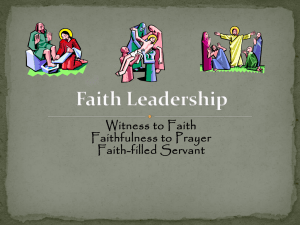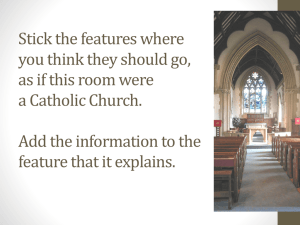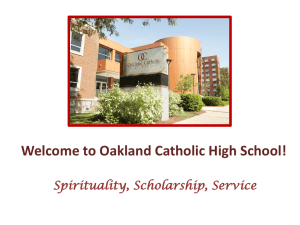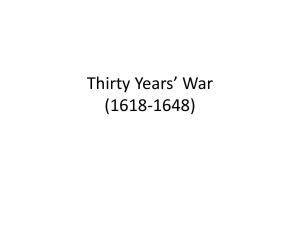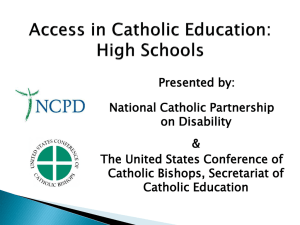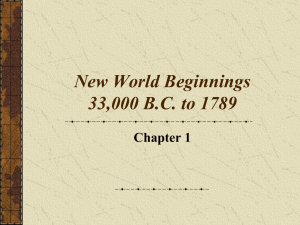Common Core- Sr. John Mary Fleming
advertisement
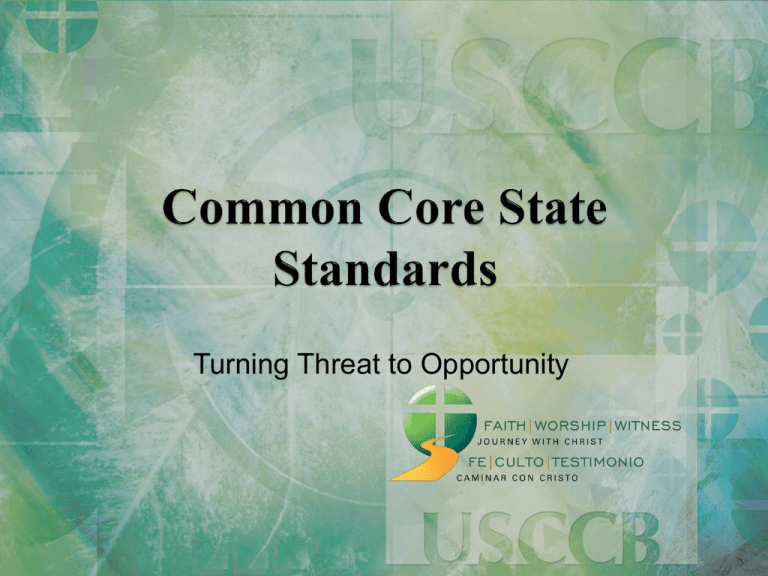
Turning Threat to Opportunity “GINORMOUS” national debate Catholic identity, mission and purpose Assessment/standardized testing Textbook and resource materials Data mining and privacy issues Common Core State Standards #Common Core: take the best, leave the rest! Paused • 195 Dioceses in the United States • 178 Latin Catholic Arch/Dioceses • 17 Eastern Rite Eparchies Percentage of Participation Reviewed and 10% adapted Adopted 15% 60% 15% • Catholic schools must consider standards that support the mission and purpose of the school as a Catholic institution. • The Common Core State Standards should be neither adopted nor rejected without review, study, consultation, discussion and caution. • In the Church, the principle of subsidiarity directs that human events are best handled at the lowest possible level, closest to the individuals affected by the decisions being made. This principle provides a great strength for Catholic schools as it gives the local diocesan and school community the ability to make decisions at the school level related to guidelines and curriculum. It also allows for adjustments and adaptations to be made by teachers and administrators for the children under their care. The great strength of Catholic schools is that they control and direct their own curricula. The Committee encourages a rigorous discussion at the local level that reinforces a solid understanding of the philosophy and mission of Catholic schools with a clear rationale for the standards and guidelines implemented by the diocese. The CCSS was developed for a public school audience. The CCSS is of its nature incomplete as it pertains to the Catholic school. Our schools have resisted the need to adopt educational trends while addressing the ever changing needs of children in education. We have tried to integrate the best in education while leaving behind what is not appropriate to the Church’s educational mission. “The fundamental theory of liberty upon which all governments in this Union repose excludes any general power of the state to standardize its children by forcing them to accept instruction from public teachers only. The child is not the mere creature of the state; those who nurture him and direct his destiny have the right, coupled with the high duty to recognize and prepare him for additional obligations.” The responsibility of a Catholic school is enormous and complex. It must respect and obey the laws that define methods, programs, structure, etc., and at the same time it must fulfill its own educational goals by blending human culture with the message of salvation into a coordinated program; it must help each of the students to actually become the "new creature" that each one is potentially, and at the same time prepare them for the responsibilities of an adult member of society. Religious Dimensions of Education in a Catholic School: Guidelines for Reflection and Renewal, #100 This means that a Catholic school needs to have a set of educational goals which are "distinctive" in the sense that the school has a specific objective in mind, and all of the goals are related to this objective. Concretely, the educational goals provide a frame of reference which: defines the school's identity: in particular, the Gospel values which are its inspiration must be explicitly mentioned; gives a precise description of the pedagogical, educational and cultural aims of the school; presents the course content, along with the values that are to be transmitted through these courses; describes the organization and the management of the school; determines which policy decisions are to be reserved to professional staff (governors and teachers), which policies are to be developed with the help of parents and students, and which activities are to be left to the free initiative of teachers, parents, or students; indicates the ways in which student progress is to be tested and evaluated. Religious Dimensions of Education in a Catholic School: Guidelines for Reflection and Renewal, #100 “It has been said that we live in a knowledge-based society. However, Catholic schools are encouraged to promote a wisdom-based society, to go beyond knowledge and educate people to think, evaluating facts in the light of values. They educate people to take on responsibility and duties, and exercise active citizenship.” Educating to Intercultural Dialogue in Catholic Schools: Living in Harmony for a Civilization of Love, #66 Teaching young people the Gospel of Jesus Christ Environment of a love of learning Beauty of the good moral life taught in the Catholic tradition Excellent habits of mind and heart Respect for the dignity of the human person Love of the sacramental life of the Church 1. How can the present debate about the Common Core help us to begin to address a relativistic approach in our standards and curriculums? 2. How do we ensure that the standards/guidelines we claim as our own support the distinctive mission and purpose of Catholic schools? 3. How can we best communicate to parents what is distinctive about our standards, goals, and objectives so as to show the integration of faith in reason on our curriculums? 4. What would we identify at the diocesan level as obstacles to an integrated Catholic curriculum and what can we do to remove some of the obstacles? 5. What opportunities/threats do the Common Core State Standards present to the viability of our Catholic schools? The bishops who attended the Synod on the New Evangelization said: “If evangelization is to be true to itself, it cannot take place apart from education; it is directly related to it.” Thank you!!
